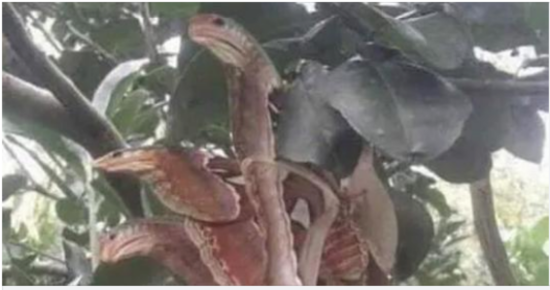The planet Earth and the natural world are filled with an abundance of incredible and captivating species. It’s truly fascinating to witness the diverse ways in which organisms interact and adapt to their surroundings, ensuring their survival and maintaining a harmonious balance within their ecosystems.
I was naturally curious when I stumbled upon pictures of three “angry snakes” concealed in a tree. It appears that I’m not the only one who has been tricked by these remarkable images.
Seeing three serpents gathered in a tree can definitely give you the chills. Just one snake in a tree is scary on its own. Luckily, those striking images are not real snakes; they’re something completely different.

Nature is home to a wide range of species, collectively known as biodiversity, with millions of different organisms. Each species plays a unique role in its ecosystem. Additionally, many animals and plants have developed incredible adaptations and survival skills throughout the years.
Some insects have developed camouflage colors to blend in with their environment and avoid predators. On the other hand, certain insects have produced toxic compounds as a defense mechanism against predators.
In 2021, Rob Allam shared a puzzling photo on Twitter that seemed to reveal three furious-looking “serpents” hiding in a tree. This truth became even clearer as images of the angry creatures started spreading online.
Users soon discovered that the story was actually more intricate than it initially seemed.

The group of “snakes” is in fact just a fragment of the wings from two distinct types of the Atlas moth, creating a mesmerizing optical illusion.
This incredible species of moth, exclusively found in the Asian jungles, possesses a unique talent for mimicking the appearance of a snake. The Atlas moth, known for its impressive size, is one of the largest Lepidoptera species, boasting a wingspan that can extend up to 24 cm (9.4 in) and a wing surface area of over 160 cm2 (25 in2).
The Atlas moth’s body is significantly smaller compared to its wings, creating a noticeable size difference. This giant insect, first documented by Carl Linnaeus in 1758, is one of the largest on Earth. Its name is derived from the Greek mythological figure Titan Atlas.

Rob, a Twitter user, posted the viral picture and included the following description:
He wrote about Attacus Atlas, one of the biggest butterflies in the world. During its adult phase, it only lives for a short period of two weeks. Its main goal during this time is to lay eggs and protect them until they hatch, all while disguising itself as a snake.
It took some time for a lot of social media users to believe that the creature in question was actually a moth.
“That disguise is really good,” one user wrote.
Another person was surprised and commented, “Why isn’t that first one a real snake? This moth would have a longer life if it didn’t resemble something I want to hit with a broom.”
Atlas moths are actually not known for their strong flying abilities. They tend to rest during the day and become more active flyers at night to save energy.

The National History Museum states that the Atlas moth has a defense mechanism where it drops to the ground, wriggles, and flaps its wings in a way that mimics a snake’s head when it feels threatened.
To witness the magnificent Atlas moth, one might have to journey to the tropical forests of Asia. Nevertheless, sightings of these impressive creatures have also been documented in various parts of Europe and the US.
In 2012, the BBC reported an intriguing incident about a gigantic Atlas moth spotted on a windowsill in Ramsbottom, Greater Manchester. The moth was incredibly huge, causing the family who stumbled upon it to mistake it for a bat at first glance. This unique species is believed to have escaped from someone’s personal collection. Unfortunately, it didn’t survive for long after its discovery.

In July 2022, a rare Atlas moth was spotted in Bellevue, Washington, marking a significant event. This sighting was particularly historic as it was the first time this species had been seen in the United States. Another one was also found in Sweden in the same year.
Sven Spichiger, the managing entomologist for the state Agriculture Department, described this insect as a fascinating creature due to its impressive size, stating, “It’s truly remarkable!”
He mentioned, “Even if you’re not actively searching for bugs, this is the kind that makes people grab their phones and snap a photo – they’re just that eye-catching.”

Encountering such a magnificent species would definitely leave me in awe and surprise. I would immediately reach for my camera to capture the moment, ensuring it becomes a lasting memory. Yet, if it began to resemble a snake’s head, I would make sure to keep a safe distance.
Consider sharing this post on Facebook to spread the word about this incredible and captivating moth. It’s truly remarkable and deserves recognition for its extraordinary characteristics and unexpected presence in unfamiliar surroundings!
